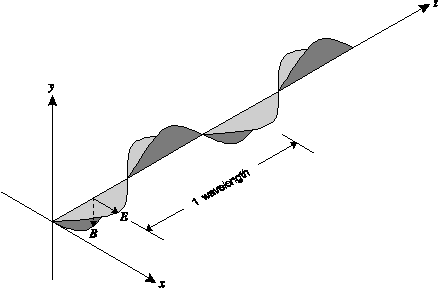合成孔径雷达原理(一)
Electromagnetic Theory
Unlike optical and infrared imaging sensors which are inherently passive, meaning they rely on reflected or radiated energy, radar is an active sensor--providing its own illumination in the form of microwaves. Microwaves are electromagnetic (EM) waves in approximately the 1-1000 GHz region of the EM spectrum, as illustrated in Figure 1.

Figure 1. The electromagnetic spectrum. Fuzzy lines indicate an imprecise boundary between regions.
An electromagnetic wave is a self-propagating wave (requiring no medium to travel through) consisting of electric and magnetic fields whose intensities follow a sinusoidal pattern. These fields are perpendicular to each other and in phase as shown in Figure 2.

Figure 2. An electromagnetic wave propagating in the z-direction.
One wavelength ( ) is the distance from one crest to the next crest. The frequency (f)
of the wave is the number of crests to travel one wavelength per unit
time. The propagation velocity (or phase velocity) of the wave is
dependent on the medium through which it is traveling. It is calculated
as:
) is the distance from one crest to the next crest. The frequency (f)
of the wave is the number of crests to travel one wavelength per unit
time. The propagation velocity (or phase velocity) of the wave is
dependent on the medium through which it is traveling. It is calculated
as:

where  and
and  are
the permeability and permittivity, respectively, of the medium. These
are inherent electromagnetic qualities specific to different types of
matter. The lowest values these can have are
are
the permeability and permittivity, respectively, of the medium. These
are inherent electromagnetic qualities specific to different types of
matter. The lowest values these can have are  0and
0and  0 which occur for a vacuum (free space). Thus the maximum velocity of light is within a vacuum and is equal to:
0 which occur for a vacuum (free space). Thus the maximum velocity of light is within a vacuum and is equal to:

Air is so diffuse that within it the velocity of an EM wave can still be considered to be c. The wavelength and frequency are related to the velocity by the equation:

where v is the velocity in metres per second, f is the frequency in Hertz (cycles per second) and  is the wavelength in metres.
is the wavelength in metres.
The ratio of the electric field intensity E to the magnetic field intensity B at any moment is always equal to the speed of light in a vacuum.

The polarization of the EM wave refers to the direction of the electric field vector. In radar science, the wave is said to be polarized in the direction of its E vector.
Principles of Real Aperture Radar
The two main types of radar images are the circularly scanning plan-position indicator (PPI) images and the side-looking images. The PPI applications are limited to the monitoring of air and naval traffic. Remote sensing applications use the side-looking images which are divided into two types--real aperture radar (usually called SLAR for side-looking airborne radar or SLR for side-looking radar) and synthetic aperture radar (SAR).
The SLAR imaging system uses a long, straight antenna mounted on a platform (aircraft or satellite), with its longitudinal axis parallel to the flight path. The antenna emits pulses of electromagnetic energy directed perpendicular to the flight path of the platform and downward to the surface of the Earth, as illustrated in Figure 3. These pulses fall within a narrow area on the ground and are scattered, usually in many directions, including the direction of the antenna. The return echoes arrive at the antenna at different times, depending on the distance from the antenna to the specific scattering object on the ground.







